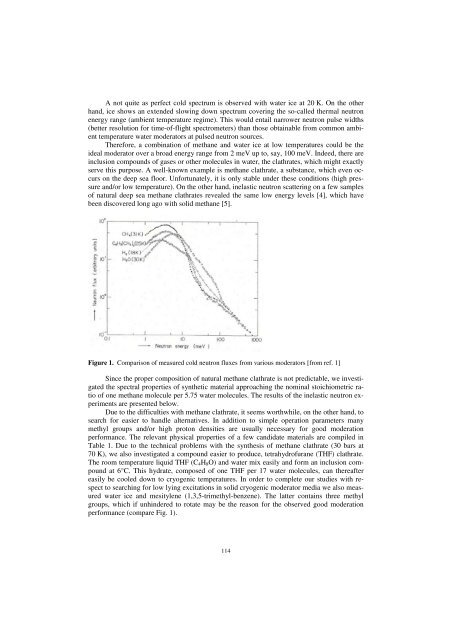Druck-Materie 20b.qxd - JUWEL - Forschungszentrum Jülich
Druck-Materie 20b.qxd - JUWEL - Forschungszentrum Jülich
Druck-Materie 20b.qxd - JUWEL - Forschungszentrum Jülich
Create successful ePaper yourself
Turn your PDF publications into a flip-book with our unique Google optimized e-Paper software.
A not quite as perfect cold spectrum is observed with water ice at 20 K. On the other<br />
hand, ice shows an extended slowing down spectrum covering the so-called thermal neutron<br />
energy range (ambient temperature regime). This would entail narrower neutron pulse widths<br />
(better resolution for time-of-flight spectrometers) than those obtainable from common ambient<br />
temperature water moderators at pulsed neutron sources.<br />
Therefore, a combination of methane and water ice at low temperatures could be the<br />
ideal moderator over a broad energy range from 2 meV up to, say, 100 meV. Indeed, there are<br />
inclusion compounds of gases or other molecules in water, the clathrates, which might exactly<br />
serve this purpose. A well-known example is methane clathrate, a substance, which even occurs<br />
on the deep sea floor. Unfortunately, it is only stable under these conditions (high pressure<br />
and/or low temperature). On the other hand, inelastic neutron scattering on a few samples<br />
of natural deep sea methane clathrates revealed the same low energy levels [4], which have<br />
been discovered long ago with solid methane [5].<br />
Figure 1. Comparison of measured cold neutron fluxes from various moderators [from ref. 1]<br />
Since the proper composition of natural methane clathrate is not predictable, we investigated<br />
the spectral properties of synthetic material approaching the nominal stoichiometric ratio<br />
of one methane molecule per 5.75 water molecules. The results of the inelastic neutron experiments<br />
are presented below.<br />
Due to the difficulties with methane clathrate, it seems worthwhile, on the other hand, to<br />
search for easier to handle alternatives. In addition to simple operation parameters many<br />
methyl groups and/or high proton densities are usually necessary for good moderation<br />
performance. The relevant physical properties of a few candidate materials are compiled in<br />
Table 1. Due to the technical problems with the synthesis of methane clathrate (30 bars at<br />
70 K), we also investigated a compound easier to produce, tetrahydrofurane (THF) clathrate.<br />
The room temperature liquid THF (C4H8O) and water mix easily and form an inclusion compound<br />
at 6°C. This hydrate, composed of one THF per 17 water molecules, can thereafter<br />
easily be cooled down to cryogenic temperatures. In order to complete our studies with respect<br />
to searching for low lying excitations in solid cryogenic moderator media we also measured<br />
water ice and mesitylene (1,3,5-trimethyl-benzene). The latter contains three methyl<br />
groups, which if unhindered to rotate may be the reason for the observed good moderation<br />
performance (compare Fig. 1).<br />
114

















